A little more unknown military history on just how one small battle in South Africa has shaped some of the greatest men of our time, including, believe it or not, Mahatma Gandhi, the famous Indian political reformer and spiritual leader.
Gandhi’s formative years were in South Africa and many don’t know this, but he even took part in the 2nd Anglo Boer War. He was also present at the battle of Spionkop, fighting for the British Army as a stretcher bearer and medic.
Spionkop is such a significant battle that three future heads of government were present, Winston Churchill, Mahatma Gandhi and Louis Botha. As a result, South Africa, and that battle in particular, played a significant role in moulding the contemporary history of the world in the years to come, simply because of the way the battle influenced these three men.
Background to the Battle of Spion Kop
After much sabre rattling over British immigrant workers rights on the mines in the Zuid-Afrikaansche Republiek (Transvaal Republic) and Rhodes’ Imperial expansionist visions, The 2nd Anglo Boer War was officially declared by the Boers on 11 October 1899 when they invaded the British Colonies of Natal and the Cape.
The move by two relatively small Boer Republics – the South African Republic (Transvaal) and Orange Free State Republic – to declare war on what was then the world’s only real superpower – The United Kingdom (Great Britain) – came with some astonishment to Queen Victoria and the British Government. The British expansionist Imperialists in Southern Africa, along with the Gold and Diamond mining magnates, on the other hand, could hardly believe their luck.
From the Boer’s perspective, the pressures Milner had put on Paul Kruger’s government to grant citizenship rights to mainly British mine workers on the Rand had simply become too much to bear. Numerically speaking there were to be more miners than Boers in the Transvaal and the granting of such rights would have ended Boer governance of the province eventually – simply by the ballot alone.
As with the 1st Anglo Boer War (or Transvaal War as it was known) fought 20 years earlier from 16th December 1880 until 23rd March 1881, the Boers banked on a quick and decisive victory over the British Colonial forces in Natal and the Cape (which were somewhat weaker than Boer forces at the start of the 2nd Anglo Boer war), and bring to an end the United Kingdom’s demands on them and give them an upper hand in re-establishing their peaceful relations with their British neighbours – exactly as they had done after their victory over the British at The battle of Majuba in the 1st Anglo Boer War.
The Boer advance was however stopped by three small garrison armies at the British border towns of Mafeking, Kimberley and Ladysmith. The Boers promptly put all three of these towns to siege and brought up heavy artillery and cannons to bombard them, both the garrisons and the civilians alike came under repeated and constant fire, the British citizens in these towns – especially women and children, were forced to near starvation and were now living rough in bunkers, mine shafts and caves. This prompted an outrage back in Britain and fuelled by public opinion of the arrogance of it all Queen Victoria was able to draft the biggest British expeditionary force ever seen to go to Southern Africa and get their towns back. Central to all of this was the plight of the citizens in Ladysmith – Ladysmith was to become the pride of the British empire in Southern Africa and the rally call.
General Sir Redvers Henry Buller VC landed in Cape Town on the 31st October 1899 to appraise the situation, the main body of the first wave of expeditionary forces due to arrive shortly afterward by 10 November 1899. By the beginning of December 1899 Buller had assembled all his forces in Durban to begin the relief of Ladysmith – what the British did not expect was to get was a resounding beating, ‘Black Week’ awaited them.
Buller’s woes in Natal started with the Battle of Colenso – which was the third and final battle fought during the ‘Black Week’ – 10th to 17th December 1899 (the other two been resounding Boer victories at Magtersfontein and Stormberg in the Cape Colony),
At the Battle of Colenso, fought on the 15th December 1899, Buller’s forces came up against well entrenched Boer forces under the command of General Louis Botha (the first of the men profiled here). Despite a brave attempt to ‘save the guns’ at Colenso, inadequate preparation and reconnaissance and uninspired leadership led to a heavy, and in some respects humiliating, British defeat. Buller’s army lost 143 killed, 756 wounded and 220 captured. Boer casualties were only eight killed and 30 wounded. Buller retreated to reinforce, he requested even more British expeditionary battalions from the War Office by January 1900 and next up for Buller in a second attempt to relieve Ladysmith was The Battle of Spion Kop.
In a nutshell, the Battle of Spion Kop (Dutch: Spionkop; Afrikaans: Slag van Spioenkop) was fought about 38 km (24 mi) west-south-west of Ladysmith on the hilltop of Spion Kop along the Tugela River, Natal in South Africa from 23–24 January 1900. It was fought between the South African Republic (Transvaal Republic) and the Orange Free State forces under the command of General Louis Botha on the one hand and British forces under command of General Sir Redvers Henry Buller VC in their second push to relieve Ladysmith on the other hand. Spion Kop occupied the centre of the Boer line, and was therefore of strategic and tactical importance.

Iconic photograph of British dead in situation after the Battle of Spionkop
So what were these three future statesmen and reformers doing at Spion Kop? During the battle, Gandhi performed the role of a medic, Churchill acted as a courier and Botha led the Boers during the battle. So let’s have a look at these three and their involvement a little more in depth, and chart how this singular battle affected their future views and helped shape their careers.
Louis Botha
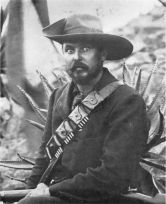 At the onset of the war in 1899, Louis Botha initially joined the Krugerdorp Commando, he fought under Lucas Meyer in Northern Natal, and later as a General commanding and leading Boer forces rather impressively at the Battle of Colenso and then at the Battle of Spion kop.
At the onset of the war in 1899, Louis Botha initially joined the Krugerdorp Commando, he fought under Lucas Meyer in Northern Natal, and later as a General commanding and leading Boer forces rather impressively at the Battle of Colenso and then at the Battle of Spion kop.
General Louis Botha’s forces came up against General Sir Redvers Buller VC forces as he was trying to relieve Ladysmith. Botha’s forces held the Tugela River and although Botha’s men were outnumbered, they were mostly equipped with modern Mauser rifles and up-to-date field guns, and had carefully entrenched their positions. In December, 1899, Buller made a frontal assault on the Boer positions at the Battle of Colenso The result was a heavy British defeat.
Over the next few weeks, Buller received further reinforcements, and he moved to cross the Tugela river and capture the hill of Spion Kop in a second attempt to advance on Ladysmith – Spion Kop lay at the centre of the Boer line, so of great strategic and tactical advantage if taken. So on the night of 23 January 1900, General Sir Charles Warren, tasked with the advance on Ladysmith, sent the larger part of his force to secure the top of Spion Kop.

Boer Forces on Spion Kop, January 1990
The British climbed up the hill at night and in dense mist. They surprised the small Boer piquet and drove them off the kop at bayonet point. The Boer piquet retreated down the hill to their camp waking up their fellow Boers by screaming “Die Engelse is op die kop.” (The English are on the hill.). At that time a half-company of British sappers began to entrench their position on the hill with a mere 20 picks and 20 shovels (oddly – while almost 1,000 soldiers stood around idle).
As dawn broke, the British discovered that they held only the smaller and lower part of the hilltop of Spion Kop, while the Boers occupied higher ground on three sides of the British position. The British had no direct knowledge of the topography of the summit and the darkness and fog had compounded the problem. Furthermore, the British trenches were inadequate for all defensive purposes. Because the summit of the kop was mostly hard rock, the trenches were at most 40 centimetres (16 in) deep and provided an exceptionally poor defensive position – the British infantry in the trenches could not see over the crest of the plateau and the Boers were able to fire down the length of the crescent-shaped trench from the adjacent peaks.

Orange Free State Republic flag
In the resultant murderous and accurate Boer rifle and artillery fire as well as Boer assaults – the British ran up an unacceptable level of casualties and deaths – in what was to become known later as the ‘murderous acre’. Although they eventually broke the Boer line after a herculean effort they withdrew from the hilltop as an exhausted and broken force, allowing the Boer’s to re-occupy it and win the day.
The British took 20,000 men and 36 Field Guns into the battle and by the end of the battle, the British suffered 243 fatalities; many were buried in the trenches where they fell and 1,250 wounded. Whilst the smaller Boer force of 8000 men, 4 Field Guns and 2 cannon only sustained 68 killed 267 wounded. It was a resounding Boer victory against the numerically superior British.

South African Republic (Transvaal) flag
The Boers, including Botha, thought that their victory at the Battle of Spion Kop would be the end of all the hostilities, and like the end of the 1st Boer War which saw a similar British defeat on the hill of Majuba – the Boers thought the British would now sue for peace and so many of them even went home. (see Observation Post Boers ‘Don’t forget Majuba, boys’. Brits ‘No fear, Boere, no fear’. for more on this battle).
Little did they foresee the ‘total war’ that was to become the 2nd Anglo Boer War and British resolve to not only take back their captured cities but also to eventually conquer the two Boer Republics with a degree of ruthlessness never before seen in South Africa, and never seen again.
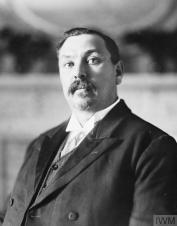
Louis Botha as the first Prime Minister of South Africa
The successes at Colenso and Spion Kop eventually saw General Louis Botha take control of all Boer Forces. However, once the British won the conventional phase of the war and captured the capital city of Pretoria, the Boer commanders decided to move their government ‘into the field’ and embark on a new Guerrilla warfare phase. This resulted in the British using heavily handed scorched earth and concentration camps systems to squeeze off supply to the guerrillas in the field. The net result of these policies is that by the end of the 2nd Anglo Boer War, the Boer Republics’ farming sector was economically broken and Boer armies and Boer people’s completely decimated.
To build their country up again General Louis Botha teamed up with General Jan Smuts to propose ‘Union’ between the two British colonies and the two Boer states, take control back in the form of an independent South African parliament from Westminster (so it would be able to make its own laws) and create a new country – South Africa. The Union of South Africa was born in 1910 with these two ex-Boer commanders leading it (without a shot been fired) and as one of these two reformers Botha took the mantle of South Africa’s very first Prime Minister.
Botha is literally the co-founder of South Africa and Smuts was very prepared to let him take the Prime Minister position as he was a far more popular man than the deep thinking broody Smuts, here Smuts felt their relationship was perfectly balanced for the work of creating a new country and all the challenges that would bring. Botha’s popularity, especially amongst the Afrikaner lay in his great deeds during the 2nd Anglo Boer War and his popular and likeable manner in command, this popularity was forged by his successes at Colenso and Spion Kop.
Botha would die in office on the 22 August 1919, and in a further ironic twist, it would be Field Marshal Smuts, Botha’s partner in Union who would go on to be come a key advisor and close friend to Winston Churchill during the invasion of France in World War 2 and the formation of the post war world. To read more on Smuts and Churchill read Observation Post “The force of his intellect has enriched the wisdom of the whole human race”- the death of Jan Smuts.
Winston Churchill
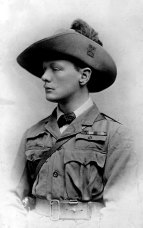 Winston Churchill took initially part in the 2nd Anglo Boer War as a ‘war correspondent’ for The Morning Post. War Correspondents like Churchill tended to be commissioned officers serving in uniform attached to Regiments or formations, their reporting was intended to toe the military line. South Africa literally made Churchill into a national hero and it is the epicentre of his rise to political greatness.
Winston Churchill took initially part in the 2nd Anglo Boer War as a ‘war correspondent’ for The Morning Post. War Correspondents like Churchill tended to be commissioned officers serving in uniform attached to Regiments or formations, their reporting was intended to toe the military line. South Africa literally made Churchill into a national hero and it is the epicentre of his rise to political greatness.
Churchill’s activities in South Africa read like a ‘Boys Own’ Adventure Novel. His impertinent nature saw him arrive in Cape Town with General Sir Redvers Henry Buller’s expeditionary force, and he immediately teamed up with journalistic colleague John B. Atkins of the Manchester Guardian to go to the front at Ladysmith before any other journalists could do so. They took a 700-mile undefended train ride, boarded a small steamer bound for Durban and promptly sailed into the teeth of an Indian Ocean storm. After several harrowing days, the pair arrived at Durban.
Still determined to get to see the Boer forces’ siege of Ladysmith ahead of Buller’s advancing forces, Churchill and Atkins made another dangerous train ride of 60 miles to within hearing range the artillery fire of the Boer guns on Ladysmith. Churchill, still keen on getting closer to the action accompanied a scouting expedition on an armored train. The train was ambushed by the Boers and on 15 November 1899, Churchill and after a firefight in which Winston played a direct combatant role, he was captured by none other than Louis Botha (the other future statesmen profiled here).

Churchill – standing off-set to the right as a POW
Churchill was imprisoned in a Prisoner of War (POW) camp. He managed to escape, and with a ransom price on his head and the assistance of an English mine manager, he eventually made his way to Delagoa Bay (Mozambique) after forging rivers, hiding in mine shafts and stowing away on a train . Hailed as a hero back in England, Churchill returned to Durban.
Here Churchill joined Buller’s advance on Ladysmith and was commissioned as a lieutenant in the South African Light Horse by General Buller whilst he was basking in the glory of his well-publicised escape from Boer captivity. By January 1900, at the Battle of Spionkop just outside Ladysmith Churchill acted as a courier to and from the summit at Spion Kop and Buller’s headquarters and made a statement about the scene: “Corpses lay here and there. Many of the wounds were of a horrible nature. The splinters and fragments of the shells had torn and mutilated them. The shallow trenches were choked with dead and wounded.”

Churchill on horseback during the 2nd Anglo Boer war, this photograph was taken just after his escape from Boer captivity.

British Union Flag
Later, after the war Churchill used his new-found status as a national hero and turned his attention to politics, winning a seat in Parliament in the 1906 general election.
Ironically, it was Winston Churchill who revealed that General Botha was the man who captured him at the ambush of the British armoured train he was travelling in on 15 November 1899. Churchill was not aware of the man’s identity until 1902, when Botha travelled to London seeking loans to assist his country’s reconstruction, and the two met at a private luncheon.
Churchill became the Chancellor of Exchequer (Cabinet Minister) in 1924 upon rejoining the Conservative Party. Churchill was outspoken on a number of issues, such as the danger of Germans re-armament after World War One. His warnings against Hitler were largely ignored, but at the outbreak of the Second World War, his foresight was acknowledged and he became the war-time Prime Minister. His speeches and military strategy were a great encouragement to the British, and he is regarded today as one of the greatest Britons of his time. It is largely due to Churchill’s leadership during the war that Britain was not invaded by Hitler’s nazi forces at the on-set of The Battle of Britain, that Britain (and Western Europe for that matter) is the modern democracy with the freedoms it enjoys today is largely thanks to Churchill (whether his detractors, of which there are many, like it or not, it remains a fact).
Mahatma Gandhi
Historians have forever struggled to explain why this apostle of peace and non-violence rendered support to the British Empire in the Boer War, the 1906 Natal Rebellion and the First World War. However what is clear by Gandhi’s own writings was that his intentions in supporting the British Army in Southern Africa was to buy the Indian population in Southern Africa more political concession and representation based on endorsement and participation in British war efforts.

Natal Colony Flag
When the Boer War came about Mahatma Gandhi actually played a pivotal role in the forming Natal Indian Ambulance Corps which fell under the British Military command. He even raised the money to form the Corps from the local Indian Community. It consisted of 300 “free” Indians and 800 indentured labourers (Indians were encouraged to emigrate to South Africa as labourers under contract, once the specified dates of the contract finished they were “free” to own land and make their own way as citizens).
In an urgent response the siege of Ladysmith the British authorities recruited the Natal Volunteer Ambulance Corps of about 1100 local White men, at the same time Gandhi pressed for his Indian stretcher-bearers to be allowed to serve, which was duly granted.
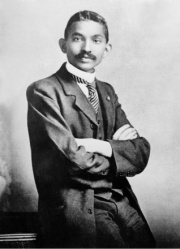 Mahatma Ghandi first saw action with Buller’s forces at the Battle of Colenso on 15 December 1899, when the Natal Volunteer Ambulance Corps we ordered to remove the wounded from the front line and then transport them to the railhead.
Mahatma Ghandi first saw action with Buller’s forces at the Battle of Colenso on 15 December 1899, when the Natal Volunteer Ambulance Corps we ordered to remove the wounded from the front line and then transport them to the railhead.
During the Battle of Spion Kop, the Natal Volunteer Ambulance Corps (including Gandhi) moved into the frontline to collect the wounded. There is even an account of Ghandi’s bearing during the Battle of Spion-Kop. Vera Stent described the work of the Indians in the Illustrated Star of Johannesburg, July 1911, as follows:
“My first meeting with Mr. M. Gandhi was under strange circumstances. It was on the road from Spion Kop, after the fateful retirement of the British troops in January 1900.
The previous afternoon I saw the Indian mule-train moved up the slopes of the Kop carrying water to the distressed soldiers who had lain powerless on the plateau. The mules carried the water in immense bags, one on each side, led by Indians at their heads. The galling rifle-fire, which heralded their arrival on the top, did not deter the strangely-looking cavalcade which moved slowly forward, and as an Indian fell, another quietly stepped forward to fill the vacant place. Afterwards the grim duty of bearer corps, which Mr. Gandhi organised in Natal, began.
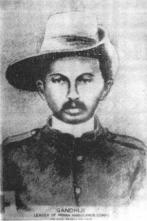 It was on such occasions the Indians proved their fortitude, and the one with the greatest fortitude was the subject of this sketch [Mr. Gandhi]. After a night’s work, which had shattered men with much bigger frames I came across Gandhi in the early morning sitting by the roadside – eating a regulation Army biscuit. Everyman in Buller’s force was dull and depressed, and damnation was heartily invoked on everything. But Gandhi was stoical in his bearing, cheerful, and confident in his conversation, and had a kindly eye. He did one good… I saw the man and his small undisciplined corps on many a field during the Natal campaign. When succour was to be rendered they were there.”
It was on such occasions the Indians proved their fortitude, and the one with the greatest fortitude was the subject of this sketch [Mr. Gandhi]. After a night’s work, which had shattered men with much bigger frames I came across Gandhi in the early morning sitting by the roadside – eating a regulation Army biscuit. Everyman in Buller’s force was dull and depressed, and damnation was heartily invoked on everything. But Gandhi was stoical in his bearing, cheerful, and confident in his conversation, and had a kindly eye. He did one good… I saw the man and his small undisciplined corps on many a field during the Natal campaign. When succour was to be rendered they were there.”
34 Indian leaders were awarded the Queen’s South Africa Medal for actions in the Boer War. Gandhi’s is held by the Nehru Memorial Museum in New Delhi.
Mahatma Ghandi remained in the military as a reservist, and was eventually promoted to the rank of Sergeant Major, he also took part in the 1906 Natal Rebellion for which he again received 1906 Rebellion Medal. For more in Gandhi’s military service see The Observation Post Gandhi was a man of peace, but he was also a man of war! .
In the below image is Gandhi as a medic on the side of the British this time, seen in this photo with the stretcher-bearers of the Indian Ambulance Corps during the Boer War, South-Africa cira 1900.
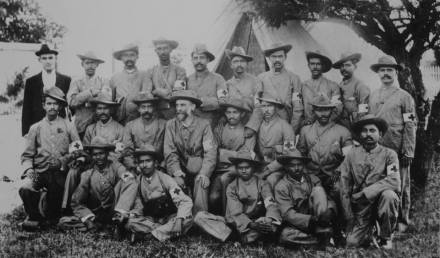
Standing: H. Kitchen, L. Panday, R. Panday, J. Royeppen, R.K. Khan, L. Gabriel, M.K. Kotharee, E. Peters, D. Vinden, V. Madanjit. Middle Row: W. Jonathan, V. Lawrence, M.H. Nazar, Dr. L.P. Booth, M.K. Gandhi (Mahatma Gandhi), P.K. Naidoo, M. Royeppen. Front Row: S. Shadrach, “Professor” Dhundee, S.D. Moddley, A. David, A.A. Gandhi.
After the wars (Boer War and Natal Rebellion), Mahatma Gandhi’s politics began to shape up as one of non violence, and no doubt his exposure to the violence on war guided Gandhi to his philosophy of peaceful resistance.
In another irony as his political career travelled in synch with that of Louis Botha, in 1910, the same year the South African Union was established, Gandhi established an idealistic community called ‘Tolstoy Farm’ near Johannesburg. It was here, based on his wartime experience and his unsuccessful experiences of trying collaborative politics with the British, that he nurtured his policy of peaceful resistance.
Mahatma Gandhi’s political path was to cross with Louis Botha and Jan Smuts on a number of occasions over the issues of Indian rights and franchise in South Africa, and although Gandhi was arrested on a number of occasions for civil dissonance, he and Smuts developed a strong mutual respect, see Observation Post “… I am not worthy to stand in the shoes of so great a man” for more on this unique relationship.
In all Mahatma Gandhi spent 22 years of his life in South Africa, a significant period of time, and there is no doubt the region’s politics and violence forged the man he had become by the time he returned to India in 1915. On arrival in India he brought with him an international reputation as a leading Indian nationalist, theorist and organiser.
He joined the Indian National Congress and was introduced to Indian issues by Gopal Krishna Gokhale, his mentor. Gandhi by the time he arrived in India was utterly devout to the ideals of non-violence and universal love. He was against “untouchability” of India’s most destitute and all sorts of injustice in society. He lived a frugal life and imposed self suffering and hunger strikes to see his ideals triumph. In essence he dreamed of a “Ram Rajya” where everybody would live in peace.
In Gandhi’s in book Hind Swaraj Gandhi outlined his ideals of change via principles of non co-operation, and he declared that British rule was established in India with the co-operation of Indians and had survived only because of this co-operation. If Indians refused to co-operate, British rule would collapse and “swaraj” (self rule) would come.
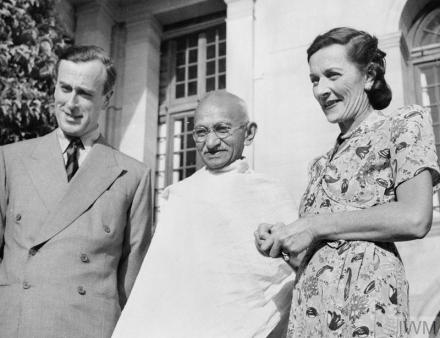
Negotiation of independence for India, Gandhi with Lord and Lady Mountbatten in 1947
Whist using this idea of non co-operation to fight British rule in India, he maintained his principles of truthfulness, peace and non-violence. In 1942, he launched the “Quit India Movement” to drive the British out of the country and gave the famous slogan of ‘do or die’ to his countrymen. The movement brought tremendous pressure on the British who eventually granted full independence to India in 1947.
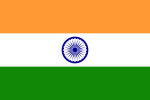
National flag of India
He even famously crossed political paths with Winston Churchill when Churchill famously commented “It is alarming and also nauseating to see Mr. Gandhi, a seditious Middle [Inner] Temple lawyer, now posing as a fakir of a type well known in the East, striding half-naked up the steps of the Viceregal palace, while he is still organizing and conducting a defiant campaign of civil disobedience, to parley on equal terms with the representative of the King-Emperor.”
Gandhi famously disarmed this typical Churchill rhetoric and insult when Gandhi wrote to Churchill in a letter saying, “Dear Prime Minister, You are reported to have a desire to crush the simple ‘naked fakir’ as you are said to have described me. I have been long trying to be a fakir and that [too] naked – a more difficult task. I, therefore, regard the expression as a compliment though unintended. I approach you then as such and ask you to trust and use me for the sake of your people and mine and through them those of the world.”
India’s cost for independence was “Partition” – the breakaway of the state of Pakistan, and the resultant violence and deep-seated religious divides resulted in the assassination of Gandhi, when he was shot three times on January 30, 1948 by a Hindi Nationalist extremist named Nathuram Godse.
Gandhi’s funeral was unprecedented – attended by over two million Indians in a massive nationwide outpouring of grief. It ushered in Mahatma Gandhi as national hero, consolidated Indian national identity and Gandhi is now considered the father of modern India.
Conclusion
What amazing twists and turns our South African military history gives us, to think, one battle in the remote Natal midlands on a rocky hill shaped the identities, careers, philosophy and politics of what can easily be regarded as the three of the greatest reformers of the 20th Century.
The Siege of Ladysmith and the Battle at Spion Kop literally made Churchill a household hero in the UK and launched his political career, it made Botha the popular leader amongst Afrikaners, which enabled him to work with Smuts to unite the Republics and British Colonies and to form a new country – South Africa and for Gandhi it changed his view on violence as a means of solving conflict and forged his views on peaceful resistance as an alternative, leading to the establishment of an independent India, free from Britain.
This chapter in South African military history literally gave birth to the fathers of modern India, modern South Africa and modern Britain.

Colourised version of the iconic image of British dead in the trench on the summit of Spionkop, taken just before it was covered over. Image colorising and copyright Tinus Le Roux
Written and researched by Peter Dickens. References – wikipedia, Imperial War Museum, SAHO – South African History on-line, the escape of Winston Churchill. Image copyright Imperial War Museum. Colourised Spionkop image copyright Tinus Le Roux

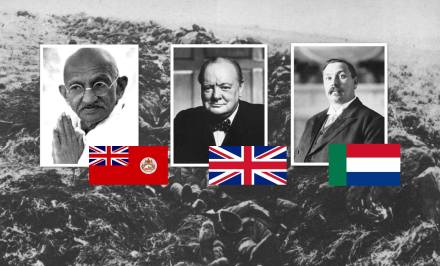






Pingback: Quick Fact: Ghandi, Winston Churchill, and future South African President Louis Botha... - Quick Facts
Pingback: Gandhi was a man of peace, but he was also a man of war! | The Observation Post
Very detailed and informative.
May i point out a spellcheck error in the word assassination near the end.
LikeLike
Thanks Gary I’ll correct it
LikeLike
So you said that the Boers declared war on the 11’th of October 1899, and the British started landing troops on 31’st of October 1899.
This is a period of 20 days.
A fast ship could travel at a speed of 20 knots in the 1890’s, so let’s assume that the 7209 nautical miles between London and Cape Town was completed at a more realistic 10 to 14 knots ( 50% less to 40% less) .
At a speed of 10 knots the ship would have traveled 30 days and at a speed of 14 knots the traveling time was 21.5 days.
At a speed of 20 knots the traveling time was 15 days.
So you expect us to believe, that in the best case scenario of a speed of 20 knots, the British could muster and and send off an expeditionary force in just 5 days for a 15 day journey to Cape Town ?
How long did the British take to send an expeditionary force to France in 1914 then ?
More like as not, the traveling time took longer. I contend that the expeditionary force was already at sea, and that the Boers were aware of this.
So the Boers had no other choice but to declare war …
… for they wanted to fight the British on the beaches …
http://ports.com/sea-route/port-of-cape-town,south-africa/port-of-london,united-kingdom/
And Ghandi must have seen the chivalry of the Boers, and he should also have seen that this forced the British to respond likewise.
And he saw this chivalrous response by the British for what it truly was to a non-christian – a weakness, an exploitable weakness.
Ghandi learned how to beat the British on the battlefields of South Africa.
LikeLike
Hi Marcellus, I tried to make it readable so people would understand without getting too lost in the small facts. Because of events unfolding in South Africa Buller was sent ahead of the main body troops with a small delegation to gauge the situation and troop requirements – he arrived in Cape Town on 31 Oct 1899, he appraised the Natal force requirements by telegraphing General White on 1 November 1899. He then telegraphed the War Office requesting a compliment of expeditionary forces needed for Natal – his reply was that the first wave of the expeditionary force would only be landing in about 10 days in Cape Town and to sit tight until then i.e. about the 10th November 1899. Subsequent requests for manpower and extra battalions continued between Buller and the War office so that he had sufficient battalions by January 1900 to deal with the crisis in Natal (the War office argued March 1900 as more realistic for his troop requests – but Buller pressed for urgent and more significant troops to SA by January 1900 given the worsening conditions and the set back at Colenso he had using the initial forces supplied to him and the local garrison and colonial forces already in Natal. The ‘major’ part of an expeditionary force was not ‘on the water’ already on their way at the start of the Boer War – for your time/speed/distance calculation you really need to work on 11 Oct to 10 Nov – 30 days.
Winston Churchill arrived with Buller’s mission at the end of Oct 1899, also to ‘fact find’ and report to his newspaper. As an amusing side, typical to Churchill he arrived with sixty bottles of spirits, twelve bottles of Rose’s Lime Juice and a supply of claret.
Gandhi’s opinion on non-violence did not really happen seeing the Boer ‘Chivalry’ as you put it – the Boers at the time were shelling civilians and it its more likely that both their behaviour and the behaviour of the British led to his views on non violence. Remember that Gandhi was still in British uniform by the time of Natal Rebellion in 1906, long after the Boer War and holding the rank of a Sgt Major in the British army.
LikeLike
(Excerpt from the Anglo-Boer War – A Chronology)
1899-10-19: A large number of German-born uitlanders meet in a Johannesburg beer hall and establish a German volunteer corps under the command of fort commandant Adolph F Schiel, acting head of the ZAR Prison Service.
1899-08-28: The Swiss Helvetia Association decide not to establish its own corps but to rather join the German Corps.
1899-08-31: Five hundred German uitlanders meet in Johannesburg and establish a second volunteer corps under HU von Quitzow.
1899-09-14: About 800 Dutchmen and Belgians meet in the Caledonian Hall and they establish a Hollander Corps under cmdt J P le G Lombard with a 150-man corps under cmdt dr HJ Coster and a 300-man ‘garrison corps’ under cmdt JM de Bruijn.
1899-09-22: Uitlanders of Scandinavian descent establish a volunteer corps under the command of Christer Uggla. However, the ZAR government does not permit Uggla to vacate his position as head of the NZASM workshop and the Natal-born Johannes Flyers (who is believed to command five languages) becomes commander in his stead .
1899-09-28: Uitlanders of French origin establish a Special Police Corps and Special Mining Police (under the command of Captain S H L de Korte) for the purpose of maintaining law and order in Johannesburg.
1899-09-29: The First Volksraad adopts Section 1442, in which they afford full citizenship rights (Letters of Voting Rights) to all volunteers joining the civilian forces. In addition to uitlanders , other foreigners such as Catholics and Jews can also now obtain suffrage in the ZAR.
The ZAR government takes over the routes (1 185 km), workshops and equipment of the Nederlandsche Zuid-Afrikaansche Spoorweg-Maatschappij (NZASM) in accordance with the emergency measures provision (Section 22) contained in the railway concession. The company’s 230 locomotives, 238 passenger and 5 230 goods vehicles can now be used for the planned mobilization. Due to the essential nature of their work, the 3 162 white staff members, who represent 26 nationalities, are specifically exempted from military duty and urged by the government to remain in their positions.
1899-09-30: The larger Rand mines (including the Simmer & Jack, the Wolhuter, the Geldenhuys Deep and the Henry Nourse) suspend mining operations . Foreigners leave the Witwatersrand at a rate of ± 4,000 a day.
1899-10-01; An Enthusiastic group of Johannesburg Irish elect the American “Colonel” JYF Blake, 43, as commander of an Irish “avengers corps” with “Majors” John Macbride and TM Menton as his officers. (Blake was trained at the US West Point military academy and has participated in the campaign against the red Indian chief Geronimo.)”
LikeLike
Amazing! No wonder the South Africans are such a tough nation- you are what your roots are?
LikeLike
A fourth well-known person was also present at the battle. In addition to Churchill, Botha and Gandhi there was Robert Baden-Powell. A remarkable collection of influential people.
LikeLike
Pingback: Churchill’s ‘Boys Own Adventure’ in South Africa vaulted him to fame | The Observation Post